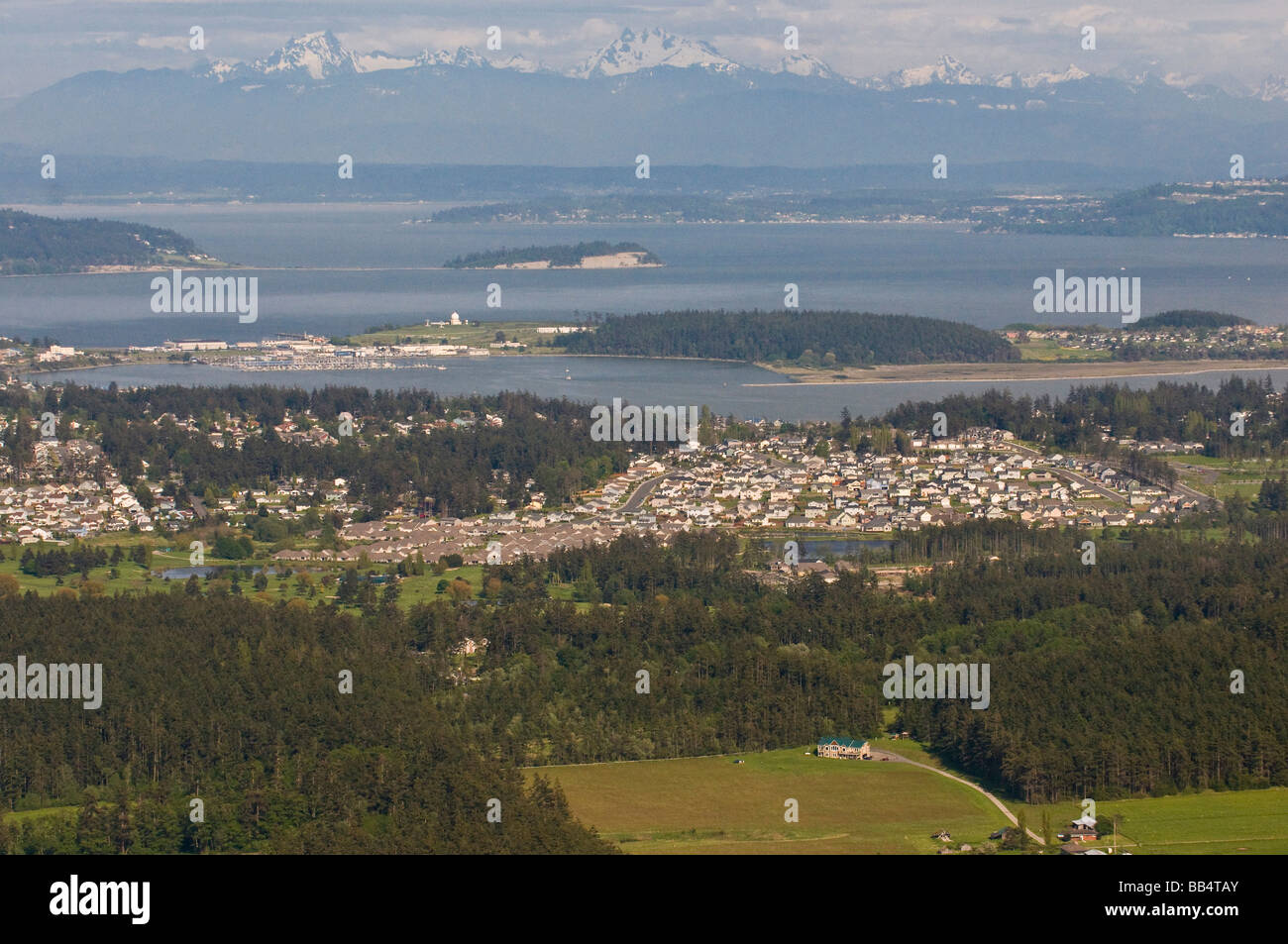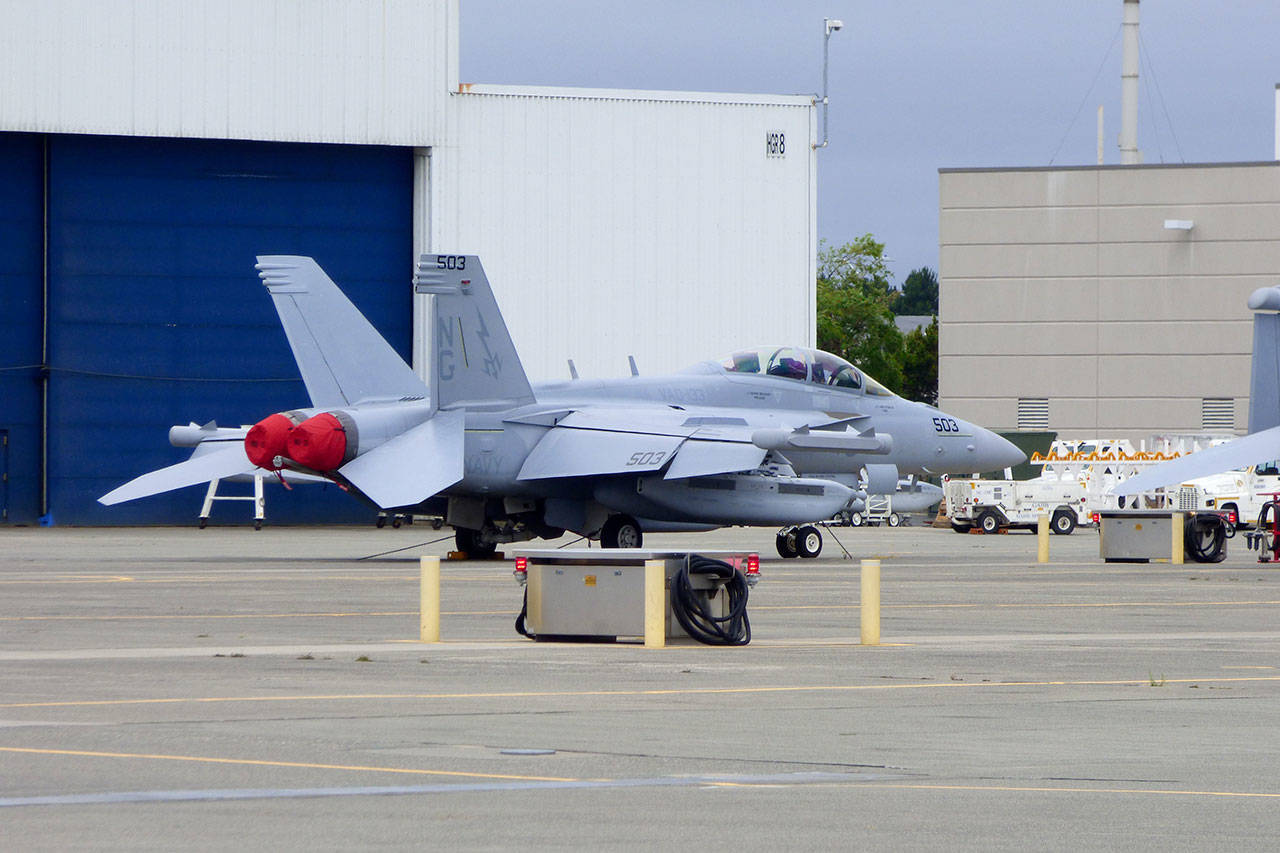Whidbey Island Base - NAS Whidbey Island is the premier naval aviation installation in the Pacific Northwest and home to all of the Navy's tactical electronic attack squadrons that fly the EA-18G Growler. The air station has eight maritime patrol and reconnaissance squadrons in depth and capability flying the P-3 Orion, P-8 Poseidon and EP-3E Aries. In total, there are 17 Active Duty Squadrons and 3 Ready Reserve Squadrons based at NAS Whidbey Island. The air station also houses a search and rescue unit that flies two Sikorsky MH-60S Nighthawks.
A military working dog on display after viewing the Growler hangar in July. The plan will be to park at the CPO Club off base (1080 W. Alt Field Road #138, Oak Harbor, WA 98277) where a tour bus will pick you up for the tour and proceed to the base. We will have a performance by VAQ (Growler Representatives) on 1000. After the show, we will go to the baseball field for the military working dog show. Finally they take you to the CPO Club outside the base.
Whidbey Island Base

The tour bus will pick us up at 1000, people should plan to arrive before that time. PT to 8 a.m.; And the way to Kingston is a bit longer, but the schedule could be better.
Oak Harbor Whidbey Island Hi Res Stock Photography And Images
Mike Spence, Carin Zwolfer, Anthony Brunetti, Gary Brunetti, Larry Tellinghuysen, Wesley King, Connie Westover, Tom Zwolfer, Steve Westover, Patricia Mickelson and Charles Mickelson visit Naval Air Station Whidbey Island on August 21, 2019. Enlarge this view : 452 × 599 pixels. Other Resolution: 181 × 240 Pixel | 362 × 480 pixels | 579 × 768 pixels | 773 × 1,024 Pixel | 1546 × 2048 pixels | 3840 × 5088 pixels.
This tag does not indicate the copyright status of the closed work. A normal copyright tag is still required. See: License.
This file is the work of a sailor or employee of the United States Navy, taken or created as part of that person's official duties. As a work of the United States federal government, it is in the public domain in the United States.
This file has been identified as having no known restrictions under copyright law, including all related and neighboring rights.
Barracks 12 Renovation
This file contains additional information such as Exif metadata that can be added by the digital camera, scanner, or software program used to create or digitize it. If the file has been modified from its original state, some details, such as timestamps, may not fully reflect the details of the original file. The timestamp is only as accurate as the clock in the camera, and it can be completely wrong.
140507-N-DC740-013 Oak Harbor, Wash. (May 8, 2014) Naval Air Station Whidbey Island. (U.S. Navy photo by Mass Communication Specialist 2nd Class John Hetherington/Released) "Alt Field" redirects here. For the CSU-designated location formerly known as Alt Field, see Whidbey Island Station (CDP), Washington.
This article needs additional citations for verification. Please help improve this article by adding quotes from reliable sources. Unsourced material may be challenged and removed. Find the source: "Naval Air Station Whidbey Island" - News Newspapers Books Scholars JSTOR (Jan 2019 ) (Learn how and when to remove this model message)

48°21'07"N 122°39'21"W / 48.35194°N 122.65583°W / 48.35194; -122.65583 Coordinates: 48°21'07"N 122°39'21"W / 48.35194°N 122.65583°W / 48.35194; -122.65583
A Brief History Of Whidbey Island
Naval Air Station Whidbey Island (NASWI) (IATA: NUW, ICAO: KNUW, FAA LID: NUW) is a naval air station of the United States Navy located on two pieces of land near Oak Harbor, on Whidbey Island, in Island County. . Washington.
The main part of the base, Alt Field, is about three miles north of Oak Harbor. The second section, called the seaplane base for the PBY Catalina flying boats once located here, houses most of the island's Navy housing, as well as the air station's main Naval Exchange and the Commissioner DCA. The NASWI commanding officer also has command of Naval Outlying Landing Field (NOLF) Coupeville, a satellite airfield on central Whidbey Island.
48°11'24"N 122°37'48"W / 48.19000°N 122.63000°W / 48.19000; -122.63000 (Naval Outlying Landing Field Coupeville), about nine miles south of Alt Field. Used primarily for Field Carrier Landing Practice (FCLP) by carrier-based jets, the field has no permanently assigned personnel.
NASWI supports MH-60S Seahawk and EA-18G Growler helicopters, P-8 Poseidon, EP-3E ARIES and C-40 Clipper fixed-wing aircraft.
Nas Whidbey Turns 75
On January 17, 1941, about 11 months before the United States entered World War II, the Office of the Chief of Naval Operations asked the commander of the 13th Naval District to rearm and fuel US Navy patrol aircraft to protect Puget Sound. find a place to fill. , Lake Ozette, Indian Island, Keystone Harbor, PN Cove, and Oak Harbor were considered and rejected due to mountainous terrain, cliff face, inaccessibility, lack of suitable beaches, and leeward costs . Within three days, the commanding officer of Naval Air Station Seattle recommended the Saratoga Passage site on the shores of Crest Harbor and Forbes Point as a suitable base for seaplane takeoffs and landings under conditions of instruments. A narrow strip of land attached to Oak Harbor is now known as Meyler's Point Capehart Housing. Dredging, filling and running water and power lines in the city were underway at the end of November when it came to finding a flat land site.
On December 8, three workers began a topographical survey of what would become the Alt Field, about four miles to the north. Construction of Alt Field began on March 1, 1942. The first aircraft landed there on August 5, with Lieutenant Newton Wakefield, a former civil engineer and aircraft pilot who later became the operations officer of the air station, carrying its SNJ single-engine trainer. A little fanfare Everyone was busy working on the still endless track.
On September 21, 1942, Captain Cyril Thomas Simrad, the first commander of the air station, read the order for the use of the facility as a naval facility. The United States Naval Air Station Whidbey Island was duly commissioned. A year later, on September 25, 1943, Commander William B. Land Plain Field was named Alt Field in memory of Alt, who had disappeared in the Battle of the Coral Sea the previous year. Following a recommendation from the Interdepartmental Air Traffic Control Board, an area 2½ miles southeast of Coupeville was approved as a support area to serve NAS Seattle. Survey work began in February 1943 and work began in March. Naval Outlying Landing Field (NOLF) Coupeville was in use until September.

At Alt Field, the first squadrons of aircraft were Grumman F4F Wildcats, which arrived in 1942, followed by Grumman F6F Hellcats. Later that year, the Lockheed PV-1 Vturas arrived for training. By the end of 1943, all Wildcats were gone, replaced by the Hellcat. In 1944, Douglas SBD Dauntless bombers became the dominant aircraft at Alt Field, while at the seaplane base, several Consolidated PBY Catalina and Martin PBM Mariner seaplanes were on board in the summer of 1944, some Martin B-26 Marauders that are based on land that year. They were used to draw targets.
Naval Air Station Whidbey Island, Boat House, Seaplane Base, Oak Harbor, Island County, Wa
After World War II, operations slowed down and the station was placed in a reduced operational state. Many naval air stations throughout the United States were closed because they could not meet the requirements of post-war naval aviation; Runways of 6,000 feet were now the minimum standard and approach paths must be suitable for radar-controlled approaches in all weathers. Lockheed P2V Neptune patrol bombers, which arrived in the late 1940s, eventually formed six patrol squadrons at NAS Whidbey.
The Korean War restored NAS Whidbey to life and accelerated expansion and construction. In the early 1950s, Whidbey's primary patrol aircraft was the Lockheed P2 Neptune. During the Korean War and the Cold War, six Neptunes were lost to attack by the Chinese, Soviets or North Koreans. One of these six Neptunes was permanently stationed at NAS Whidbey and remains the only Neptune from Whidbey lost in the attack.
While on a six-month deployment from Patrol Squadron VP-2 Whidbey to Iwakuni, Japan, on a night fighter reconnaissance mission Jan 4, 1954, BuNo 127752, a P2V-5 Neptune, suffered the his only victim of combat with the loss of a radio. calls Had to do Sign 3 Cape Cod that was attacked in the Yellow Sea off the coast of China and North Korea. The Neptune flew in the vicinity of Suwon Air Base, South Korea, before crashing.
LT Jesse Beasley-PPC, LT Fredrick Traynor Prell-Co-Pilot, S Paul Dominic Morelli, S Stanley Burt Mulford, ADC Robert George Archbold-Plane Capt, AD2 James Frank Hand, AT3 Bruce David Berger, AO3 Gordon Spiekelmeier, AL2 crew Rex All Claus, and AT2 Lloyd Bernard Russink, all listed as FALL. In 2005, each crew member was awarded the Navy Combat Action Ribbon, Purple Heart, Korean Service Medal, and United Nations Service Medal. The South Korean government awarded its Korean Presidential Unity Citation and the Korean War Service Medal on M.
Interesting Things To Do On Whidbey Island
Patrol Squadron FIFTY (VP-50) moved from NAS Alameda, California in Jun 1956, returning seaplanes to NAS Whidbey. Flying the Martin P5M-2 Marlin, patrol squadrons dominated the Hydroxic base until the late 1960s with the seaplane tether, USS Salisbury Sound.
During
Post A Comment:
0 comments so far,add yours